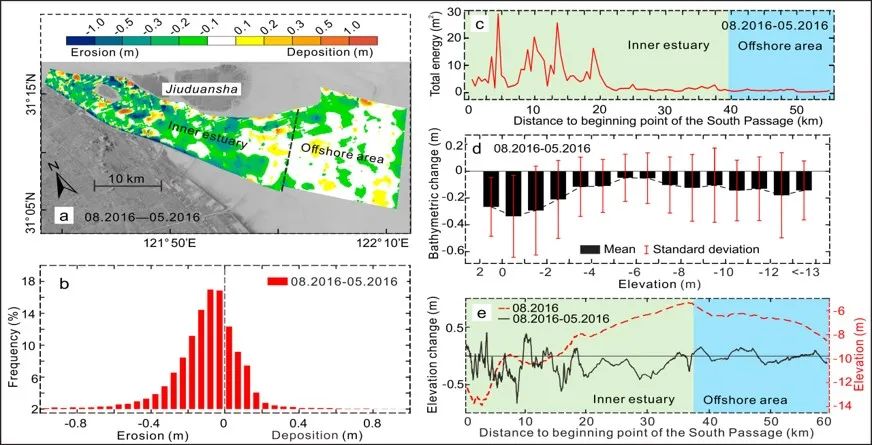Floods, especially typhoons, are the key factors affecting the balance and stability of estuarine delta morphodynamics. In the context of global warming and rising sea levels, increasing and intensifying typhoon events have posed a severe threat to the estuarine delta. In particular, the mega-deltas that are in a transitional phase of erosion and accretion due to a sharp decrease of fluvial sediment supply, and their morphological erosion and vulnerability, have attracted global concern.

P.h.D Candidate Wang Jie (first from the left) and Prof. Dai Zhijun (second from the left).
Typhoons are generally simultaneous with flood peaks or flash floods at the Changjiang Estuary. It has long been a problem to determine whether the delta morphodynamics in flood season is caused by flood peaks or typhoons. Furthermore, estuarine sediment source-sink transition in this period is the most observable both in frequency and capacity, but hard to detect.
Recently, Dai Zhijun’s team from ECNU State Key Laboratory of Estuarine and Coastal Research (SKLEC) found that high riverine flow caused 30-60 million cubic meters of sediment erosion along the south passage while typhoons brought about 9-47 million cubic meters of sediment into the estuary in flood season by quantifying the morphodynamic process of the south passage of the Changjiang Estuary under the influence of typhoons over the past two decades. Furthermore, they put forward the relationship between runoff and sediment erosion in flood season over the estuary and quantified the role of typhoon and high riverine runoff in estuarine sediment erosion and accretion.
“Typhoons bring flooding to the delta region, but they also provide sediment for the delta expansion, which can greatly compensate for delta erosion caused by fluvial sediment decline”, Prof. Dai Zhijun said. “This work is of particular practical significance, as the sediment flux from the Changjiang River to the sea has reduced by nearly 75%, which seriously affects the delta extension towards the sea. If the landward sediment transport induced by typhoons can be trapped in an effective manner, the seaward growth of tidal flats can be maintained to a large extent, which is undoubtedly useful information to solve the current urban space shortage problem in Shanghai.”
This research was published in Geophysical Research Letters on Oct. 8 with the title: Tropical cyclones significantly alleviate mega-deltaic erosion induced by high riverine flow. Wang Jie, a doctoral candidate from the SKLEC, is the first author of the paper, Prof. Dai Zhijun is the corresponding author, and Associate Prof. Mei Xuefei from SKLEC and Prof. Sergio Fagherazzi from Boston University are the co-authors.




Since the construction of the Three Gorges Dam in 2003, the annual sediment flux from the Changjiang River into the sea has decreased by approximately 75% compared that in the previous century, resulting in local erosion in the delta channel and coastal region. Frequent typhoon and flood events have also caused large scale morphological changes over the submerged delta, which have attracted worldwide concerns. Based on the measured bathymetric data that cover the normal, high flow, and typhoon conditions, this research quantified the differences between erosion-deposition patterns caused by high riverine flow and typhoon events and evaluated the driving mechanism of high-energy events on the morphodynamic changes in the estuary through one-dimensional fast Fourier transforms (1D-FFT) and the Shannon's diversity index (SHDI).

This research was jointly funded by the Key Projects of Intergovernmental Science and Technology Innovation Cooperation of the Ministry of Science and Technology in China, the International Science and Technology Cooperation Foundation Projects of Shanghai Science and Technology Commission, the Fundamental Research Funds for the Central Universities, and ECNU’s Academic Innovation Promotion Program for Excellent Doctoral Students.
Source: SKLEC
Copyeditor: Philip Nash
Editor: Zhang Linlan


















